Find more information in the General Comments section of the assessment
Find more information in the Rating Validity tab of the assessment
- See More
- See More
- See More
- See More
- Good
- Adequate
- Marginal
- Weak
- Poor
 Passenger
Passenger
 Driver
Driver
 Front Seat
Front Seat
 Car
Car
 Pole
Pole
- Good
- Adequate
- Marginal
- Weak
- Poor


Passenger
outboard
center
Fitted to the vehicle as standard
Not fitted to the test vehicle but available as option
Not Available
-
Infants up to 13 kg
-
Infants and toddlers up to 18 kg
-
Toddlers from 9 to 18 kg
-
Toddlers over 18 kg
Easy
Difficult
Safety critical
Not allowed
| Seat Position | ||||
|---|---|---|---|---|
| Front | 2nd row | |||
| Passenger | Left | center | Right | |
| Maxi Cosi Cabriofix (Belt) | ||||
| Britax Römer King Plus (Belt) | ||||
| Britax Römer Duo Plus (ISOFIX) | ||||
| Britax Römer KidFix (Belt) | ||||
| Maxi Cosi Cabriofix & EasyFix (Belt) | ||||
| Maxi Cosi Cabriofix & EasyFix (ISOFIX) | ||||
| BeSafe iZi Kid X3 ISOfix (ISOFIX) | ||||
| Maxi Cosi Pearl & Familyfix (ISOFIX) | ||||
| Britax Römer KidFix (ISOFIX) | ||||
Easy
Difficult
Safety critical
Not allowed
Based on dummy readings in the dynamic tests, the Q50 was awarded maximum points for its protection of both the 1½ and the 3 year infants. In the frontal impact, forward movement of the head of the 3 year dummy, sat in a forward-facing restraint, was not excessive. In the side impact, both dummies were properly contained by the protective shells of their restraints, minimising the likelihood of head contact with parts of the vehicle interior. The front passenger airbag can be disabled to alow a rearward-facing child restraint to be used in that seating position. Clear information is provided to the driver regarding the status of the airbag and the system was rewarded. The dangers of using a rearward-facing restraint in that seat without first disabling the airbag are clearly indicated inside the vehicle. All of the child restraints could be properly installed and accommodated in the car and Infiniti will update the information in the user manual to reflect this.
- Good
- Adequate
- Marginal
- Weak
- Poor

Head Impact 19.1 Pts
Pelvis Impact 0.0 Pts
Leg Impact 5.1 Pts
The Q50 is equipped with an 'active' bonnet. Sensors detect when a pedestrian has been hit and the bonnet is automatically raised to provide greater clearance to the hard structures beneath. Infiniti demonstrated that the system operated robustly and deployed correctly over a range of vehicle speeds and for different statures of pedestrian. Accordingly, the car was tested with the bonnet in the deployed (raised) position. Test results showed good or adequate protection to a pedestrian's head over the whole bonnet surface with a few poor results recorded on the stiff windscreen pillars. The protection provided by the bumper to pedestrians' legs was good in some areas and marginal in others. The protection provided by the front edge of the bonnet was poor in all of the areas tested and the car scored no points in this area.
- Good
- Adequate
- Marginal
- Weak
- Poor
| Speed Limitation Function | Manually Set |
| System Name | VDC | |
| Performance | ||
| Vehicle Yaw Rate @ COS + 1.00 s | 2.7% | meets ECE requirements |
| Vehicle Yaw Rate @ COS + 1.75 s | 2% | meets ECE requirements |
| Lateral Displacement @ BOS + 1.07 s | 3.7 m | meets ECE requirements |
| Applies To | All seats | ||
| Warning | Driver Seat | Front Passenger(s) | Rear Passenger(s) |
| Visual | |||
| Audible | |||
|
|||
--safetyAssistCommentEN--
- Specifications
- Safety Equipment
- Videos
- Rating Validity
Specifications
Tested Model Infiniti Q50 2.2d 'Premium', LHD
Body Type - 4 door saloon
Year Of Publication 2013
Kerb Weight 1723kg
VIN From Which Rating Applies - applies to all Q50s of the specification tested
Class Executive Car
Safety Equipment
Note: Other equipment may be available on the vehicle but was not considered in the test year.
Fitted to the vehicle as standard
Fitted to the vehicle as option
Not fitted to the test vehicle but available as option
Not Available
Not Applicable
Videos
Rating Validity



Find more information in the General Comments section of the assessment
 Share
Share
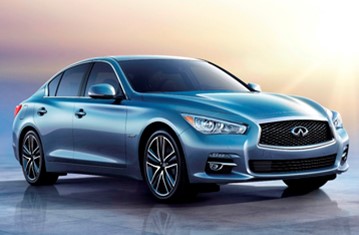
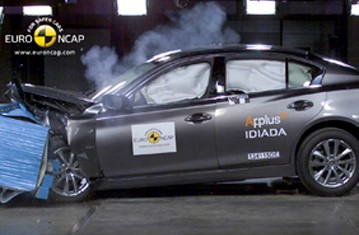
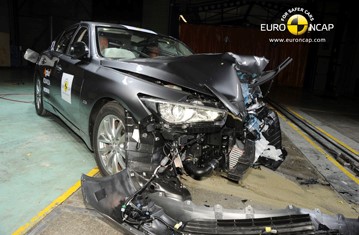
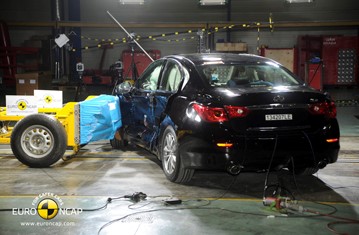
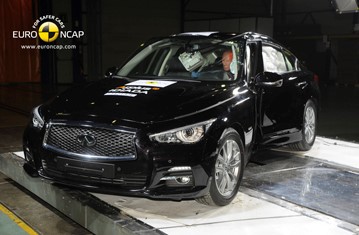




The passenger compartment of the Q50 remained stable in the frontal impact. Dummy readings indicated good protection of the knees and femurs of the driver and passenger. Infiniti showed that a similar level of protection is provided to occupants of different sizes and to those sat in different positions. In the side barrier test, dummy readings indicated good protection of all body regions. However, owing to incorrect deployment of the side thorax/pelvis airbag in the pole test, the scores for these two body regions was penalised in the side barrier impact. After the side pole test, it was observed that the vent hole of the airbag which protects the thorax and pelvis had caught on part of the door trim and had torn, resulting in much quicker deflation of the airbag and potentially reduced protection to the occupant. The scores for chest and pelvis were reduced, resulting in a marginal rating for chest protection. Euro NCAP has been informed that, from early April 2014 (VINs from build number 230447), the armrest attachment was modified to make sure it will not interact with the side airbag. The front seats and head restraints provided good protection against whiplash injury in the event of a rear-end collision.